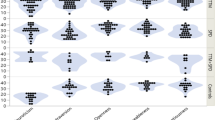Abstract
In September 2019, the New York Times (NYT) published the article “Fighting the Shame of Skin Picking,” which discussed the cosmetic, social and emotional impacts of body-focused repetitive behaviors (BFRBs). BFRBs, including excoriation disorder, trichotillomania, onychotillomania, and onychophagia, are recurring actions that damage one’s physical appearance. The aim of this study is to characterize the demographic information provided and themes raised in the 166 comments posted in response to the article. The most commonly reported condition was skin picking (38.2%), followed by trichotillomania and/or trichophagia (30.3%), onychotillomania (24.7%), and onychophagia (23.6%). All conditions had a female predominance. Treatment of body-focused repetitive behaviors was the most common topic of discussion, followed by shame and impact on appearance. Since commenters described significant impairments to quality of life, larger randomized controlled trials on skin picking, trichotillomania, onychophagia, and onychotillomania are necessary to provide evidence-based management to patients.



Similar content being viewed by others
Abbreviations
- BFRB:
-
Body-focused repetitive behaviors
- CI:
-
Confidence interval
- NAC:
-
N-Acetylcysteine
- NYT :
-
The New York Times
- OR:
-
Odds ratio
- SNRI:
-
Serotonin–norepinephrine reuptake inhibitors
- SSRI:
-
Selective serotonin reuptake inhibitors
References
Sampaio DG, Grant JE (2018) Body-focused repetitive behaviors and the dermatology patient. Clin Dermatol 36(6):723–727
Teng EJ, Woods DW, Twohig MP, Marcks BA (2002) Body-focused repetitive behavior problems: prevalence in a nonreferred population and differences in perceived somatic activity. Behav Modif 26(3):340–360
Houghton DC, Alexander JR, Bauer CC, Woods DW (2018) Body-focused repetitive behaviors: more prevalent than once thought? Psychiatry Res 270:389–393
Jafferany M, Vander Stoep A, Dumitrescu A, Hornung RL (2010) The knowledge, awareness, and practice patterns of dermatologists toward psychocutaneous disorders: results of a survey study. Int J Dermatol 49(7):784–789
Gellman L (2019) Fighting the shame of skin picking. New York Times 2019. https://ww.nytimes.com/2019/09/05/well/live/fighitng-the-shame-of-skin-picking.html. Accessed 25 Sept 2019
Tucker BT, Woods DW, Flessner CA et al (2011) The skin picking impact project: phenomenology, interference, and treatment utilization of pathological skin picking in a population-based sample. J Anxiety Disord 25(1):88–95
Grzesiak M, Reich A, Szepietowski JC, Hadrys T, Pacan P (2017) Trichotillomania among young adults: prevalence and comorbidity. Acta Derm Vereol 97(4):509–512
Pacan P, Grzesiak M, Reich A, Kantorska-Janiec M, Szepietowski JC (2014) Onychophagia and onychotillomania: prevalence, clinical picture and comorbidities. Acta Derm Vernerol 94(1):67–71
Winebrake JP, Grover K, Halteh P, Lipner SR (2018) Pediatric onychophagia: a survey-based study of prevalence, etiologies, and co-morbidities. Am J Clin Dermatol 19(6):887–891
Jafferany M, Patel A (2019) Skin-picking disorder: a guide to diagnosis and management. CNS Drugs 33(4):337–346
Woods DW, Houghton DC (2014) Diagnosis, evaluation, and management of trichotillomania. Psychiatr Clin N Am 37(3):301–317
Halteh P, Sher RK, Lipner SR (2017) Onychophagia: a nail-biting conundrum for physicians. J Dermatol Treat 28(2):166–172
Halteh P, Scher RK, Lipner SR (2017) Onychotillomania: diagnosis and management. Am J Clin Dermatol 18(6):763–770
Gupta MA, Gupta AK (2019) Self-induced dermatoses: a great imitator. Clin Dermatol 37(3):268–277
Lipner SR, Scher RK (2017) Comment on “Psychocutaneous disease: clinical perspectives”. J Am Acad Dermatol 77(5):e141–e142
Sousa D, Pinto D, Araujo R et al (2010) Gingival abscess due to an unusual nail-biting habit: a case report. J Contemp Dent Pract 11(2):1085–1091
Moghare V, Kumar J, Kamate S et al (2015) Association between harmful oral habits and sign and symptoms of temporomandibular joint disorders among adolescents. J Clin Diagn Res 9(8):45–48
Lipner SR, Scher RK (2017) Periungual and oral verruca. J Cutan Med Surg 21(3):251
Creath CJ, Steinmetz S, Roebuck R (1995) A case report. Gingival swelling due to a fingernail-biting habit. J Am Dent Assoc 126(7):1019–1021
Grant JE, Chamberlain SR (2016) Trichotillomania. Am J Psychiatry 173(9):868–874
Cison H, Kus A, Popowicz E, Szyca M, Reich A (2018) Trichotillomania and trichophagia: modern diagnostic and therapeutic methods. Dermatol Ther 8(3):389–398
Bohne A, Keuthen N, Wilhem S (2005) Pathologic hairpulling, skin picking and nail biting. Ann Clin Psychiatry 17(4):227–232
Krooks JA, Weatherall AG, Holland PJ (2018) Review of epidemiology, clinical presentation, diagnosis and treatment of common psychiatric causes of cutaneous disease. J Dermatol Treat 29(4):418–427
Selles RR, McGuire JF, Small BJ et al (2016) A systematic review and meta-analysis of psychiatric treatments for excoriation (skin-picking) disorder. Gen Hosp Psychiatr 41:29–37
Sani G, Gualtieri I et al (2019) Drug treatment of trichotillomania, excoriation disorder and nail-biting. Curr Neuropharmacol 17:775–786
Grant JE, Odlaugh BL, Kim SW (2009) N-acetylcysteine, a glutamate modulator, in the treatment of trichotillomania: a double-blind, placebo-controlled study. Arch Gen Psychiatry 66:756–763
Bloch MH, Panza KE, Grant JE, Pittenger C, Leckman JF (2013) N-acetylcysteine in the treatment of pediatric trichotillomania: a randomized, double-blind, placebo-controlled add-on trial. J Am Acad Child Adolesc Psychiatry 52:231–240
Grant JE, Chamberlain SR, Redden SA, Leppink EW, Odlaugh BL, Kim SW (2016) N-acetylcysteine in the treatment of excoriation disorder: a randomized clinical trial. JAMA Psychiatry 73:490–496
Ghanizadeh A, Derakhshan N, Berk M (2013) N-acetylcysteine versus placebo for treating nail biting, a double-blind randomized placebo controlled clinical trial. Antiinflamm Antiallergy Agents Med Chem 12:223–228
Funding
None.
Author information
Authors and Affiliations
Corresponding author
Ethics declarations
Conflict of interest
Claire Stewart and Dr. Lipner have no conflicts of interest related to the content of this manuscript.
Additional information
Publisher's Note
Springer Nature remains neutral with regard to jurisdictional claims in published maps and institutional affiliations.
Rights and permissions
About this article
Cite this article
Stewart, C., Lipner, S.R. Insights into recurrent body-focused repetitive behaviors: evidenced by New York Times commenters. Arch Dermatol Res 312, 629–634 (2020). https://doi.org/10.1007/s00403-020-02045-6
Received:
Revised:
Accepted:
Published:
Issue Date:
DOI: https://doi.org/10.1007/s00403-020-02045-6



